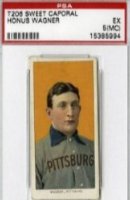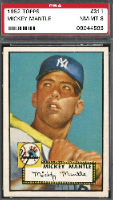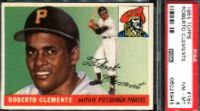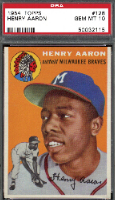1976 O-Pee-Chee/OPC #198 AL Stolen Base Leaders
Mickey Rivers, Claudell Washington & Amos Otis.

Please wander around the website for more info, prices, values & images
on vintage baseball, football, basketball, hockey, sport and non-sports cards.
NHL's Original Hockey Teams
|

Auction's most costly vintage baseball cards



The history of vintage baseball card auctions is long and colorful.
Over 5,000 vintage sports and non-sports items in each weekly auction
T-206 Honus Wagner tobacco cards have sold for upto $2.8 million in
auction. The "Holy Grail of Sports Cards", it's extreme-high auction
value can mostly be attributed to great PR and "auction fever".
It's not close to being the rarest baseball card and Honus Wagner is not
Babe Ruth or Mickey Mantle. Yes, the T-206 set is beautiful & special but
because of the # of cards and scarcities, few collector's try to complete,
which should keep auction competition down compared to say 1933 Goudey
or 1952 Topps baseball card issues. There's a story Wagner banned his card because he was anti-tobacco but there are other stories about financial considerations. You surely have heard of PSA and may even know that this card was the FIRST they ever graded. But did you know that dealer (B.l. .ast.o name encoded) admitted tampering with the card, perhaps having it trimmed down to size, before PSA graded it so highly for the auction.
|

There are many different ways to protect, organize and store your sports cards.
Soft Sleeves also called "penny sleeves" are the most basic protection for your cards. Made of thin plastic, they come in packs of 100 and are very inexpensive.
Top Loads are rigid plastic holders and a step up in protection over "soft sleeves". Called top-loads because you place the card thru a thin opening at the top. They come in many sizes for regular cards upto 8-1/2 x 11 for magazines and even larger.
Screw-Down Acrylic Holders
These are sometimes used for better, more expensive cards. Small screws hold
two pieces of clear acrylic together. In a variety of sizes and thickness
that not only protect the card but can funciton as a paper weight or display
item.
There are also Single-Screw Screw-Downs that use only 1 screw to seal the holder. They are easier to use and provide the same type of protectionas regular screwdowns and they are also much less expensive costing as little as .30 in quantity while 1 inch or 2 inch acrylic screw-downs can cost upto several dollars.
